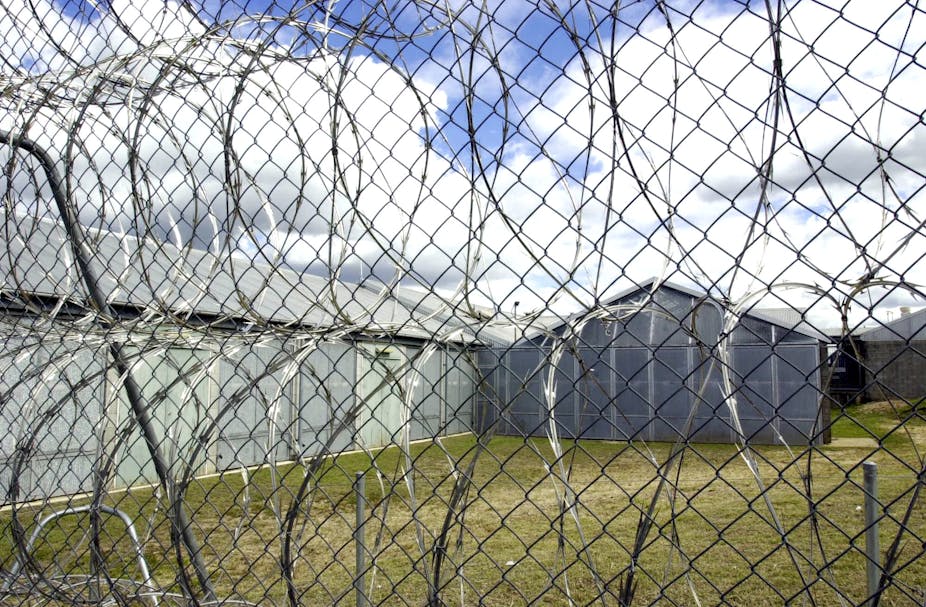This article is part of The Conversation’s series, State of Imprisonment, which provides snapshots of imprisonment trends in each state and territory. The intention is to provide a basis for informed public discussion of imprisonment policies and of the costs and consequences for Australia of rising rates of incarceration.
Queensland’s rate of imprisonment has recently undergone a reversal, following several years of what appeared to be a declining trend. Contrary to other states and territories, from 2002 to 2012 the rate of imprisonment in Queensland dropped by 6% from 168 to 159 prisoners per 100,000 adults. In 2013 this trend reversed and by 2014 the rate had reached 193 prisoners per 100,000, a 21% increase over the 2002 figure.
In addition, over this period Queensland Corrective Services (QCS) has increasingly accommodated prisoners in high-security rather than low-security prisons. In 2013, capacity in high-security facilities was at 93% compared to 63% in low-security facilities.
The increase in prisoner numbers and greater use of high-security facilities might seem to indicate that Queensland has recently become more punitive, with tougher and longer sentences. However, evidence suggests at least part of the rise in prison numbers may be due to the greater proportion of offenders who return to prison either following or during a period of supervision in the community.
For several years, Queensland has led other states and territories in these kinds of returns to prison. For example, the 2014 Report on Government Services showed that the state’s rate of returns to prisons was 34.1% compared to the Australian average 24.8%. Queensland’s rate of return was nearly nine percentage points higher than second-placed NT.
What is driving the ‘revolving door’?

The recent rise in imprisonment is unlikely to be due to changes in the state’s crime rate. Long-term crime trends show a steady decline over the past 12 years. And while some might blame recent government policies, given their open promotion of “get tough” strategies related to crime control and correctional policy, the picture is a bit more complex than this.
One contributing factor is the increased use of court-ordered parole in combination with decreased use of suspended sentences. The Corrective Services Act 2006 (QLD) stated that parole would be the only option for early release from prison. As a result, other forms of gradual or conditional release from prison, including work release, temporary absences or home detention, were no longer available.
In traditional forms of parole, parole boards determine the date of release following a period of good behaviour. Although this form of parole continued to exist for offenders sentenced to terms of three years or more, the Act introduced court-ordered parole for offenders who have committed less serious offences and are sentenced to three years or less. In these cases, courts set the date of parole release at sentencing and parole could begin at any point. In effect, offenders could serve their entire sentence in the community on parole.
The aim of court-ordered parole was ostensibly to increase the level of supervision for offenders in the community. All sentenced offenders would receive at least some level of supervision – though the intensity of this supervision would vary. But court-ordered parole has also been pitched as an alternative to suspended sentences by providing magistrates with a supervised alternative.
However, evidence suggests that a large proportion of these offenders either return to prison as a result of a breach, leading to suspension or cancellation of the order, or after committing a new offence. For instance, our research indicates that about one in four court-ordered parolees return to prison on a new offence after a three-year follow-up, in contrast to about one in ten board-ordered parolees.
The reality is that the often minimal level of supervision may increase the amount of scrutiny without providing much of the kind of support that offenders might require for successful re-entry.
The increasingly constricted level of funding and resources devoted to community corrections might also contribute to this result. Funding restrictions limit the nature and extent of supervision that parole officers with growing caseloads can provide. They also reduce the availability of post-prison programs.
Certainly changes in the “back-end” release policies – such as court-ordered parole – may have contributed to a revolving-door situation in which offenders frequently return to prisons. It is possible that the less frequent use of suspended sentences contributed because parolees are more closely monitored, increasing the detection of breaches. However, researchers Menéndez and Weatherburn have found, to the contrary, that suspended sentences may actually lead to a rise in the imprisonment rate.
Whatever the reason, the issue is to find some way to deal with the rising trend, and especially with the high levels of offender breaches.
Community reparation and rehabilitation work best
Recent evidence demonstrates the importance of focusing on re-entry and reparation in two important ways.
First, research has demonstrated the importance of sanctions that combine punishment with programs that help re-establish the offender in the community. These emphasise punishment in the community rather than removal from society – and include a range of reparative sanctions and rehabilitative community sanctions.
Second, helping offenders find and keep work has been shown to promote offender change. This contributes to successful re-entry to society. Investing in prison training and programs as well as prisoner re-entry programs reduces the risk of re-offending.
In Queensland, where QCS has provided vocational and educational training programs, evidence indicates very positive results. Rates of re-offending have fallen for prisoners who enrol in these programs.
Our research shows that completion of in-prison vocational and educational training lowers the risk of re-imprisonment. In a forthcoming publication, we show that these work programs are important starting points for offenders to change their patterns of behaviour, forging new non-offending identities.
These types of programs will make a difference in helping offenders reintegrate by tackling the risk factors for offending.
You can read other articles in the State of Imprisonment series.

